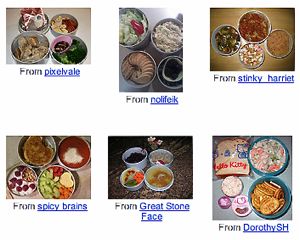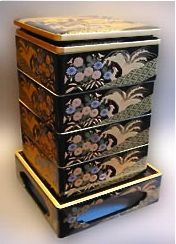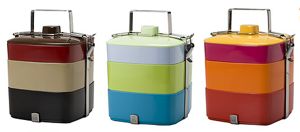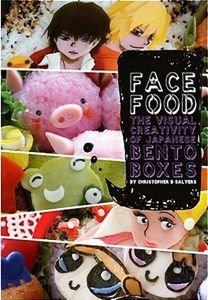
On display through the wonderful internets are hundreds upon thousands of photographs of everyday lunches. No soggy PB&J’s here, though. One forum, the Mr. Bento Porn Flickr group, posts their collective creative efforts to make mid-day meals visually appealing, healthful, delicious and, yes, a little easier on the wallet. Their cousin site, Diet Bento, includes impressively low calorie counts for those whose 2008 resolutions (for now at least) include trimming down a little of their own belly fat.

Portable meals have been with us for as long as farmers have trudged off to their fields and soldiers have marched on in war. The Japanese took it a little further, of course. Where other countries preferred banana leaves or woven baskets, Japanese al fresco diners preferred compartmentalized boxes. By the 17th century, bento meals became elaborately arranged celebrations of the full moon and cherry blossoms, a leisurely way to enjoy intermission with friends at the theatre or, like the older form of sushi, essential food for travelers in an age before planes and bullet trains.
Fast forward to the 20th century for aluminum tins, insulated containers, microwaveable cups and, last but not least, those brightly colored, plastic Hello Kitty boxes that accompany kids to school. Adult versions abound, too, although Ichiban Kan’s bento aisle seems pretty well populated by over-twenty-somethings. For those who want to pack with style, Plastica offers a sleek, stackable set in elegant colors.

Japan is not the only country with distinctive lunch boxes. Vietnam has its aluminum ca men that families carry every morning to the market to pick up breakfast, a different soup in each of the layers prepared exactly as each person prefers. The beautifully painted enamel tins of Malaysia are collectors’ items, while in India, no-nonsense tiffin boxes show wonder less in their appearance than in their amazing daily travels from home to office and back again.
In Japan, there are nearly 500 magazines dedicated to showing parents (read: mothers) how to pack lunches that will entice and impress. The proper order to place in the elements, the proper balance of color and flavors, the proper container for the right food, the secret to making flowers and hamsters and their favorite manga characters out of edible delights: childrens’ meals are no less subject to codification and over-the-top creativity than anything else the Japanese do.
A few English-language books attempt to translate the techniques as well as the art of bento. Some designs would only appeal to an obsessive artist with lots of free time, but many are simple and worth trying. It’s a good way to get the kids involved the night before. Lay out some ingredients, flip to a fun photo and suddenly packing lunch becomes a game. Two titles to check out are Bento Boxes: Japanese Meals on the Go for a how-to guide and Face Food: The Visual Creativity of Japanese Bento Boxes for an aesthetic treatment of the topic.

Another good resource is Biggie’s Lunch in A Box site, where parents will find excellent suggestions for getting their kids off to school with good food. She has hints that acknowledge the need for speed in addition to the desire to make lunch and snacks both healthy and fun.
Like with most good habits, packing meals for lunch requires practice and foresight at first, then as the regimen settles into a comfortable part of your day and week, merely some momentary foresight during weekend shopping and prep. Simple tips include washing and cutting your vegetables ahead of time, freezing food in smaller batches and learning to pack more flavor than bulk.
And if you just want to have a cute lunchbox without the work, well, they do make excellent take-out containers. Buy one with straps or handles to carry to your favorite deli counter and do your part to cut back on disposable ware.